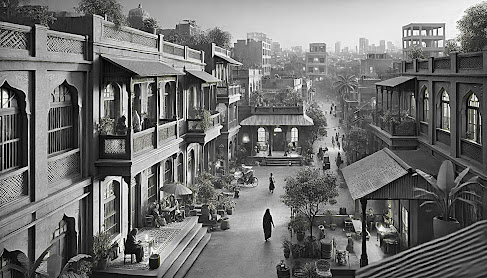"The Language of Architecture: Beyond Structures and Spaces"
While traveling through the city, I came across a street where the buildings fit so well with the surroundings. It looked so nice and beautiful, bringing a sense of comfort, with large community spaces where people could gather and connect with others. Every corner reflected a rich culture, each space telling us a story, and the entire environment remained deeply connected with nature. The space felt so welcoming and had a sense of comfort. That is when I realized how modern urban settlements, high-rise buildings, and glass Facades, bring in an overwhelming sense of confinement. Have you ever wondered why one environment feels calming while the other feels stressful? The answer lies in the "language of place"—the unspoken dialogue between architecture and human perception.
Most people believe that Architecture is just about buildings or aesthetics, although this is partially true. But, Architecture is more than that. Our built environment has a deep impact on our overall well-being. Whether we choose to notice it or not, the spaces around us shape our behaviors, thoughts, and our daily lifestyles. We often hear people complain about how anxious they feel when surrounded by industrial zones or high-rise structures, or how they feel a sense of comfort in a countryside home or any historic place. This cannot be a coincidence. "Architecture influences our emotions".
Think of a building designed in harmony with its climate and seamlessly blends into nature. Every part of it tells you a story and gives you comfort. These are not just physical attributes but signs of life within architecture. Now compare this with a modern commercial complex made entirely of steel and glass. It may look sleek, but is it alive? Does it connect with its surroundings?
Christopher Day, in his book "Places of the Soul", explores this idea. He critiques modern high-rise structures for their detachment from nature and their adverse effects on both people and the environment. He highlights examples of townhouses that seamlessly integrate with their surroundings—such as homes built with natural materials like wood, stone, and clay, which not only provide comfort but also enhance human well-being.One of the examples in his book is the concept of community-centric urban spaces. He discusses how European villages have retained their charm and functionality through organic design, where homes, gardens, and public spaces coexist harmoniously. In contrast, modern urban sprawls often create disconnection, where nature is reduced to decorative landscaping rather than an integral part of the space.
The spaces we inhabit shape our experiences in ways we often overlook. We risk creating cities that are not just unsustainable but also uncomfortable to live in. Architecture should be more than a display of modernity—it should be about creating spaces that nurture, heal, and connect.







Comments
Post a Comment